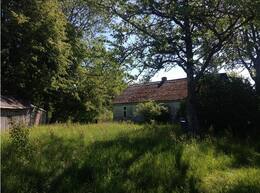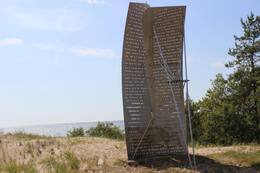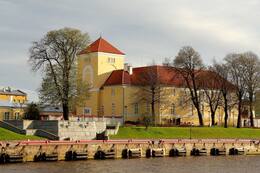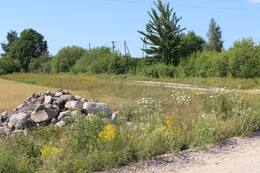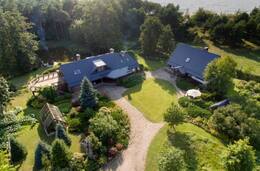Die letzte Geburtstagsfeier von Kārļis Skalbes an der Küste von Kurland
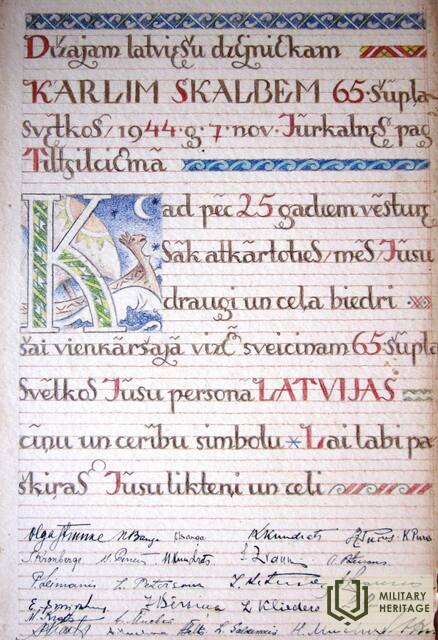
Am 7. November 1944 sorgten die Erinnerungen an den 65. Geburtstag des Dichters Kārļis Skalbe in Jūrkalnes „Laukgali“ für helle Stimmung in der lettischen Flüchtlingssiedlung an der Küste Kurlands. Nur vier Tage später reiste Kārlis Skalbe als Flüchtling mit dem Boot nach Schweden. Es war der Tag, an dem Kärlis Skalbe zum letzten Mal seinen Geburtstag feierte.
„Im grauen Alltag der Flüchtlinge war die Erinnerung an den 65. Geburtstag des Dichters Kārlis Skalbe in Jūrkalnes „Laukgaļi“ ein unvergessliches, strahlendes Erlebnis. Der Maler Niklāvs Strunke hatte bereits am 7. November in „Grīniekos“ mit der Vorbereitung einer Ansprache zum 65. Geburtstag des Dichters begonnen. Seine Arbeit war nicht einfach – kleine, dunkle Fischerzimmer und ständig Bewegung, Gedränge und Lärm. [..] Am 7. November besuchte die gesamte Flüchtlingsfamilie einzeln und in Gruppen den wunderschönen Juwelier für Lettland – den großen Dichter Kārli Skalbi. Wertvolle Geschenke wurden nicht überreicht, wie es unter anderen Umständen manchmal der Fall gewesen wäre und hätte sein sollen, es wurden keine Laudatio gehalten, jedoch brachte jeder Begrüßer die Wärme seines lettischen Herzens und eine nützliche Kleinigkeit für den täglichen Bedarf der Flüchtlinge zu den Großen Maestro. Der kranke Dichter (er war nierenkrank) hatte mit seiner Frau, seiner Tochter, seinem Schwiegersohn und seinem Enkel Andrej „Laukgali“ ein separates kleines Zimmer. Die Dunkelheit der Herbstabende wurde erst durch das Ende einer Kerze vertrieben. Ein Ingenieur und ein Agrarwissenschaftler hatten gemeinsam eine Flasche Kerosin als Geschenk mitgebracht.“
FJ Steinmanis. Kommunikationsgruppe Ventspils – „Zviedru laivas“. Ventspils 700. Sammlung von Artikeln und Erinnerungen, Toronto, 1990, S. 126.
Zugehörige Zeitleiste
Zugehörige Themen
Zugehörige Objekte
„Laukgaļi“-Haus, Wohnort des Schriftstellers Kārlis Skalbe
„Laukgaļi“ in der Gemeinde Jūrkalne, dem Wohnort des Schriftstellers Kārlis Skalbe im Oktober-November 1944, während er auf das Flüchtlingsboot nach Schweden wartete.
Gedenkschild für Flüchtlinge "Segel der Hoffnung" in Jūrkalne
Das "Sail of Hope"-Gedenkschild für die Flüchtlinge des Zweiten Weltkriegs, die 1944 und 1945 mit dem Boot über die Ostsee auf die schwedische Insel Gotland kamen. Das Denkmal befindet sich in Osvalki auf den Dünen zwischen dem Meer und der Autobahn Ventspils-Liepaja, in der Nähe der Haltestelle "Kaijas". Es wurde von dem Bildhauer Ģirts Burvis geschaffen, der es als ein Segel der Hoffnung, das die Erinnerung an die lettischen Flüchtlinge symbolisiert, realisiert hat.
Zwischen Herbst 1944 und Frühjahr 1945 versuchten einige lettische Bürger, die die erneute sowjetische Besatzung fürchteten, aber nicht bereit waren, in das zerstörte und bedrohte Deutschland zu fliehen, das nächstgelegene neutrale Land, Schweden, auf dem Seeweg zu erreichen. Einige der Boote wurden vom lettischen Zentralrat mit Hilfe der westlichen Alliierten organisiert, was zu einer der größten Flüchtlingskonzentrationen in der Gemeinde Jūrkalnes führte. Neben den vom lettischen Zentralrat organisierten Booten wurden auch andere Boote über das Meer gebracht. Es wird geschätzt, dass etwa 5000 Personen die Überfahrt geschafft haben. Die Zahl der Todesopfer ist unbekannt, da keine Aufzeichnungen über die Flüchtlinge geführt wurden, die die Küste von Kurzeme verließen.
Die Überfahrten waren gefährlich, da die Flüchtlinge durch deutsche Patrouillen an der Küste und auf See, Seeminen, sowjetische Flugzeuge und Kriegsschiffe sowie Stürme bedroht waren, da die Überfahrten oft in ungeeigneten und überladenen Kuttern und Booten ohne ausreichende Treibstoff- und Lebensmittelvorräte, Seekarten und Navigationsinstrumente stattfanden. Die Abfahrten von Lettland aus erfolgten im Geheimen. Das Ziel der Boote war die Insel Gotland, und die Fahrten begannen meist an der Westküste Kurlands (von Jūrkalne nach Gotland sind es 90 Seemeilen oder etwa 170 Kilometer Luftlinie).
Gefängnis im Schloss des Livländischen Ordens während des Zweiten Weltkriegs
1944–1945 im in Livland eingerichteten Gefängnis Oden Castle. Im Jahr 2016 wurden mehrere Mitglieder der LCP-Kommunikationsgruppe Ventspils und die Fahrer von Flüchtlingsbooten festgenommen.
Die Straße zu den „Grīnieku“-Häusern in der Gemeinde Vārve
Der Weg zum „Grīnieku“-Haus in der Gemeinde Vārve, wo sich 1944 eine der Hauptsiedlungen für Bootsflüchtlinge an der Küste Kurlands befand.
Gedenkschild für Flüchtlinge "Segel der Hoffnung" in Jūrkalne
Das "Sail of Hope"-Gedenkschild für die Flüchtlinge des Zweiten Weltkriegs, die 1944 und 1945 mit dem Boot über die Ostsee auf die schwedische Insel Gotland kamen. Das Denkmal befindet sich in Osvalki auf den Dünen zwischen dem Meer und der Autobahn Ventspils-Liepaja, in der Nähe der Haltestelle "Kaijas". Es wurde von dem Bildhauer Ģirts Burvis geschaffen, der es als ein Segel der Hoffnung, das die Erinnerung an die lettischen Flüchtlinge symbolisiert, realisiert hat.
Zwischen Herbst 1944 und Frühjahr 1945 versuchten einige lettische Bürger, die die erneute sowjetische Besatzung fürchteten, aber nicht bereit waren, in das zerstörte und bedrohte Deutschland zu fliehen, das nächstgelegene neutrale Land, Schweden, auf dem Seeweg zu erreichen. Einige der Boote wurden vom lettischen Zentralrat mit Hilfe der westlichen Alliierten organisiert, was zu einer der größten Flüchtlingskonzentrationen in der Gemeinde Jūrkalnes führte. Neben den vom lettischen Zentralrat organisierten Booten wurden auch andere Boote über das Meer gebracht. Es wird geschätzt, dass etwa 5000 Personen die Überfahrt geschafft haben. Die Zahl der Todesopfer ist unbekannt, da keine Aufzeichnungen über die Flüchtlinge geführt wurden, die die Küste von Kurzeme verließen.
Die Überfahrten waren gefährlich, da die Flüchtlinge durch deutsche Patrouillen an der Küste und auf See, Seeminen, sowjetische Flugzeuge und Kriegsschiffe sowie Stürme bedroht waren, da die Überfahrten oft in ungeeigneten und überladenen Kuttern und Booten ohne ausreichende Treibstoff- und Lebensmittelvorräte, Seekarten und Navigationsinstrumente stattfanden. Die Abfahrten von Lettland aus erfolgten im Geheimen. Das Ziel der Boote war die Insel Gotland, und die Fahrten begannen meist an der Westküste Kurlands (von Jūrkalne nach Gotland sind es 90 Seemeilen oder etwa 170 Kilometer Luftlinie).
„Bambaļi“-Häuser – einer der Hauptunterkünfte für Bootsflüchtlinge
Die restaurierten „Bambaļi“-Häuser in Ošvalki, Gemeinde Jūrkalne, waren einer der Hauptansiedlungsorte für Bootsflüchtlinge an der Küste von Kurland.





